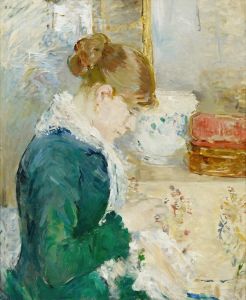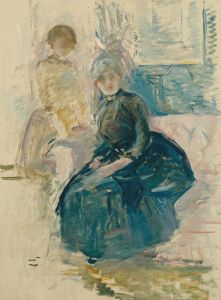
Portrait de Mademoiselle Labillois
A hand-painted replica of Berthe Morisot’s masterpiece Portrait de Mademoiselle Labillois, meticulously crafted by professional artists to capture the true essence of the original. Each piece is created with museum-quality canvas and rare mineral pigments, carefully painted by experienced artists with delicate brushstrokes and rich, layered colors to perfectly recreate the texture of the original artwork. Unlike machine-printed reproductions, this hand-painted version brings the painting to life, infused with the artist’s emotions and skill in every stroke. Whether for personal collection or home decoration, it instantly elevates the artistic atmosphere of any space.
Berthe Morisot, a prominent French Impressionist painter, is known for her delicate and nuanced portrayals of domestic life and intimate scenes. One of her works, "Portrait de Mademoiselle Labillois," exemplifies her unique style and artistic approach. Morisot was a key figure in the Impressionist movement, which sought to capture the fleeting effects of light and color in everyday scenes. Her work often focused on women and children, reflecting her interest in the private and domestic spheres.
"Portrait de Mademoiselle Labillois" is a testament to Morisot's skill in capturing the essence of her subjects with a light and fluid touch. The painting features Mademoiselle Labillois, a figure about whom little is known, which is not uncommon in Morisot's work, as she often painted friends, family, and acquaintances. The portrait is characterized by Morisot's signature brushwork, which is both loose and expressive, allowing the viewer to sense the immediacy and intimacy of the moment.
Morisot's use of color in this painting is subtle yet effective, employing a palette that enhances the softness and gentleness of the subject. Her ability to convey emotion and personality through minimal detail is a hallmark of her style. The background of the portrait is typically Impressionistic, with a focus on light and atmosphere rather than detailed realism, which serves to highlight the subject's presence and expression.
Berthe Morisot was one of the few women who were central to the Impressionist movement, and her work often explored themes related to femininity and the roles of women in society. Her paintings provide insight into the lives of women during the late 19th century, a time when their roles were largely confined to the domestic sphere. Morisot's art challenges these limitations by presenting women as complex and nuanced individuals.
Throughout her career, Morisot exhibited alongside other leading Impressionists, including Claude Monet, Edgar Degas, and Pierre-Auguste Renoir. Her work was well-received, and she gained recognition for her contributions to the movement. Despite the challenges faced by women artists of her time, Morisot's talent and determination allowed her to carve out a significant place in the art world.
"Portrait de Mademoiselle Labillois" is an example of Morisot's ability to blend the personal with the universal, capturing the quiet dignity and individuality of her subject. The painting reflects her commitment to portraying the inner lives of her subjects, offering viewers a glimpse into the world of 19th-century women through her Impressionist lens.
In summary, "Portrait de Mademoiselle Labillois" is a work that highlights Berthe Morisot's mastery of Impressionist techniques and her focus on the intimate and personal aspects of her subjects. Through her innovative use of color, light, and composition, Morisot created a portrait that is both a reflection of her artistic vision and a testament to her place in the history of art.


















